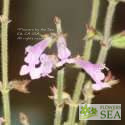(Elk Grape Ape Jame Sage) Bountiful flowers that are larger than normal for Jame Sage cover Salvia x ‘Elk Grape Ape’ in a cloud of purple that is sort of amethyst to pinot gris in color. Elk Grape Ape Sage is a short subshrub — an herbaceous perennial that’s also a bit woody — with fragrant foliage. It’s a long blooming hybrid that is a product of the FBTS plant development program.
Like most other Jame Sages, Elk Grape Ape is a heat-tolerant sun lover that appreciates a bit of partial shade during severe heat. Despite being drought tolerant, it thrives with average watering based on local rainfall. Don’t forget to give it well-drained soil, something that almost all Salvias need.
Elk Grape Ape is ideal for mixed patio containers or sunny walkways. Pair it with other short, pastel Southwestern sages or bump up the drama with low-water red sages. You can expect lots of buzz from butterflies, bees, and hummingbirds. However, deer generally stay away from sages, most likely due to the aromatic essential oils of their foliage.
Native to Mexico and the American Southwest, Jame Sages occur in areas where the closely related species of Autumn Sage ( Salvia greggii) and Mountain Sage (Salvia microphylla) meet, such as near the Village of Jame in Mexico's Sierra Madre mountains or in the test gardens of our Northern California farm. This parentage may include other species of sages as well, so these hybrids come in a broad range of sizes. The foliage of Jame Sages can favor any of their parent plants. Elk Grape Ape has glossy, veined leaves that are a bit larger than those of a typical Mountain Sage.

A Rainbow of Quality
At Flowers by the Sea, we regularly develop new cultivars such as our hybrid series of Elk Rainbow Sages™, which are varieties of Jame Sage Hybrids (Salvia x jamensis) in a broad array of solids and bicolors ranging from pastels to brights. Attractive to hummingbirds and honeybees, they are lovely yet tough crosses that include Autumn Sage (Salvia greggii) and Mountain Sage (Salvia microphylla). The word Elk in the scientific and common names of the Elk Rainbow choices indicates that you are getting a sturdy, colorful, reliable repeat performer.






